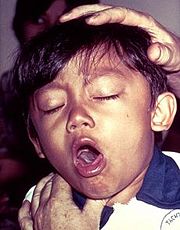Pertussis Toxin-ATP Complex
From Proteopedia
(Difference between revisions)
| Line 6: | Line 6: | ||
==Structure== | ==Structure== | ||
| - | The [http://en.wikipedia.org/wiki/Pertussis_toxin pertussis toxin] has been characterized as being an AB toxin meaning that there are 2 subunits: A subunit possesses the enzyme activity and the B subunit possesses | + | The [http://en.wikipedia.org/wiki/Pertussis_toxin pertussis toxin] has been characterized as being an AB toxin meaning that there are 2 subunits: A subunit possesses the enzyme activity and the B subunit possesses the receptor binding portion. PT in particular is an AB5 toxin consisting of a six-component protein complex, and the multiple subunits of the complex are not identical in composition.<ref name=Hazes>PMID: 8637000</ref> With that in mind, this protein is a hexamer containing a catalytic (S1) subunit that is tightly associated with the pentameric cell-binding component (B-oligomer).<ref name=Hazes>PMID: 8637000</ref> The S1 component is a single subunit <scene name='Pertussis_Toxin-ATP_Complex/Subunit_1/3'>S1 (chains A,G)</scene> while the B-oligomer is a pentamer composed of four types of subunits: <scene name='Pertussis_Toxin-ATP_Complex/Subunit_2/3'>S2 (chains B,H)</scene>, <scene name='Pertussis_Toxin-ATP_Complex/Subunit_3/5'>S3 (chains C,I)</scene>, two copies of <scene name='Pertussis_Toxin-ATP_Complex/Subunit_4/3'>S4 (chains D,E,J,K)</scene>, and <scene name='Pertussis_Toxin-ATP_Complex/Subunit_5/4'>S5 (chains F,L)</scene>.<ref name=Hazes>PMID: 8637000</ref> The overall structure of PT <scene name='Pertussis_Toxin-ATP_Complex/Whole_monomer/2'>multisubunit complex</scene>. These subunits are encoded by ptx genes, which are encoded on a large PT [http://en.wikipedia.org/wiki/Operon operon] that includes additional genes as well such as Pti genes. Together the PT and Pti proteins form the PT secretion complex and toxin itself.<ref name=Weiss>PMID: 8464913</ref> |
==Pertussis Toxin activation== | ==Pertussis Toxin activation== | ||
Revision as of 22:15, 15 November 2011
| |||||||||||
References
- ↑ 1.00 1.01 1.02 1.03 1.04 1.05 1.06 1.07 1.08 1.09 1.10 1.11 1.12 Hazes B, Boodhoo A, Cockle SA, Read RJ. Crystal structure of the pertussis toxin-ATP complex: a molecular sensor. J Mol Biol. 1996 May 17;258(4):661-71. PMID:8637000 doi:10.1006/jmbi.1996.0277
- ↑ 2.0 2.1 Carbonetti NH, Artamonova GV, Mays RM, Worthington ZE. Pertussis toxin plays an early role in respiratory tract colonization by Bordetella pertussis. Infect Immun. 2003 Nov;71(11):6358-66. PMID:14573656
- ↑ Cornia PB, Hersh AL, Lipsky BA, Newman TB, Gonzales R. Does this coughing adolescent or adult patient have pertussis? JAMA. 2010 Aug 25;304(8):890-6. PMID:20736473 doi:10.1001/jama.2010.1181
- ↑ Bettiol S, Thompson MJ, Roberts NW, Perera R, Heneghan CJ, Harnden A. Symptomatic treatment of the cough in whooping cough. Cochrane Database Syst Rev. 2010 Jan 20;(1):CD003257. PMID:20091541 doi:10.1002/14651858.CD003257.pub3
- ↑ Weiss AA, Johnson FD, Burns DL. Molecular characterization of an operon required for pertussis toxin secretion. Proc Natl Acad Sci U S A. 1993 Apr 1;90(7):2970-4. PMID:8464913
- ↑ 6.0 6.1 Kaslow HR, Burns DL. Pertussis toxin and target eukaryotic cells: binding, entry, and activation. FASEB J. 1992 Jun;6(9):2684-90. PMID:1612292
- ↑ Kenneth Todar, PhD. (2008). http://www.textbookofbacteriology.net/pertussis.html
- ↑ Plaut RD, Carbonetti NH. Retrograde transport of pertussis toxin in the mammalian cell. Cell Microbiol. 2008 May;10(5):1130-9. Epub 2007 Dec 31. PMID:18201245 doi:10.1111/j.1462-5822.2007.01115.x
- ↑ Kenneth Todar, PhD. (2008). http://www.textbookofbacteriology.net/pertussis.html
- ↑ Kenneth Todar, PhD. (2008). http://www.textbookofbacteriology.net/pertussis.html
- ↑ Centers for Disease Control and Prevention. http://www.cdc.gov/pertussis/clinical/treatment.html
- ↑ Altunaiji S, Kukuruzovic R, Curtis N, Massie J. Antibiotics for whooping cough (pertussis). Cochrane Database Syst Rev. 2007 Jul 18;(3):CD004404. PMID:17636756 doi:10.1002/14651858.CD004404.pub3
- ↑ Kenneth Todar, PhD. (2008). http://www.textbookofbacteriology.net/pertussis.html

